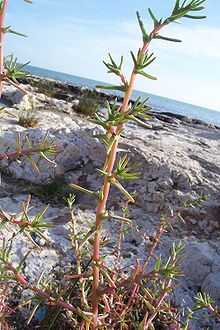Barilla
Barilla refers to several species of salt-tolerant (halophyte) plants that, until the 19th century, were the primary source of soda ash and hence of sodium carbonate.
A very early reference indicating the value placed upon soda ash in Catalonia has been given by Glick, who notes that "In 1189 the monastery of Poblet granted to the glassblower Guillem the right to gather glasswort in return for tithe and two hundred pounds of sheet glass paid annually (The site of these glassworks, at Narola, was excavated in 1935.).
[3][4][5] Fairly recently, Pérez[4] has concluded that the most prominent species was likely Halogeton sativus; earlier authors have tended to favor Salsola soda.
The word "barilla" was also used directly to refer to soda ash from any plant source, including not only the saltworts grown in Spain, but also glassworts, mangroves, and seaweed.
[7] The sodium carbonate, which is water-soluble, is "lixiviated" (extracted with water) from the ashes of the burned, dried plants.

